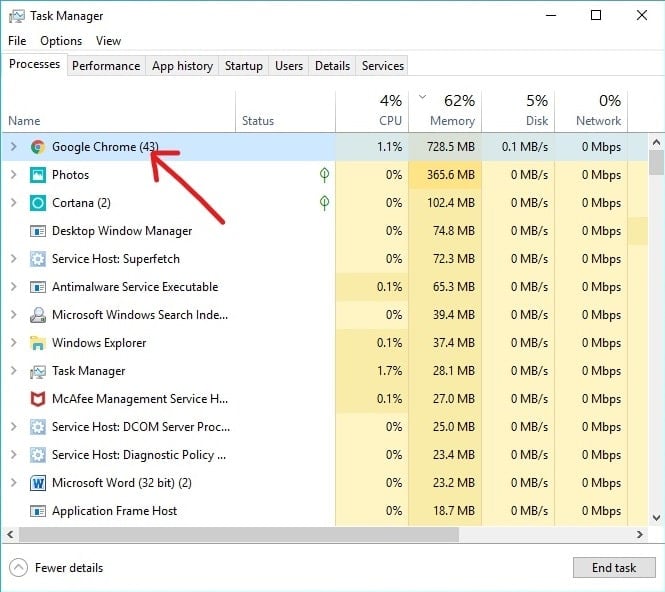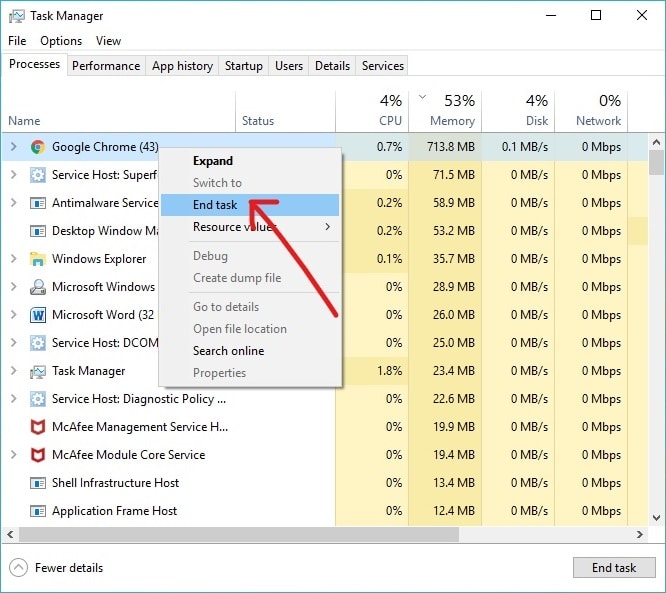We live in a busy and fast paced world where people have to multitask i.e. perform more than one task at a time. Similarly, Desktops, PCs, and Laptops also come with such features. However, when you perform multitasking or several windows open on your laptops; some of them may consume very high resources that may lead to slowing down of the system and apps stop responding.
Example of multitasking: If you are making a presentation using Microsoft PowerPoint and you require an image that you will get on the Internet. Then, obviously, you will look for it on a web browser like Google Chrome or Mozilla. While switching to the browser, a new window will open and you can just minimize the previous one and switch to the new window. Since the downloading will take place in the background, your device helps you continue working on your presentation. Such processes or applications need to be closed down or terminated which we will learn in this guide.

How to Kill Resource Intensive Processes with Windows Task Manager
Different processes or different applications running on the system consume different resources depending on their requirements. To find out which processes are consuming high resources you need to utilise “Task Manager”. Task Manager is an advanced tool that comes with windows and provides several tabs that allow monitoring of all the applications and processes running on your computer. It provides all the information related to your applications or processes that are currently running on your system including how much CPU processor they are consuming, how much memory they are occupying etc.
There are various tabs available in Task Manager which include “Processes”, “Performance”, “App History”, “Startup”, “Users”, “Details”, “Services”. Different tabs have different uses. The tab that will give information about which processes are consuming higher resources is the “Processes” tab. It consists of information on all the applications and processes running on your system at that particular time. This lists all the processes and applications in groups of:
- “Apps” i.e. applications which are running,
- “Background processes” i.e. processes that are not currently in use but running in the background and
- “Windows processes” i.e. the processes which are running on the system.
How to Identify Processes that are consuming higher resources
- If any resources run high i.e. 90% or more, there can be a problem.
- If any process color changes from light to dark orange, it will clearly indicate that the process starts consuming higher resources.
Note: Killing a process may lead to loss of unsaved data, so it is advised to save all the data before killing the process.
To stop or kill processes using higher resources follow the below steps:
1.In the Task Manager, select the process or application you want to end.

2.Click on the End Task button present at bottom right corner.

3.Alternatively, you can also end task by right-clicking at the selected process and then click End Task.

Now, the process which was causing the problem is ended or killed and it will most likely stabilize your computer.
5 Different ways to open Task Manager in Windows 10
Option 1: Right-click the taskbar and click the Task Manager.

Option 2: Open start, Search for Task Manager in Search Bar and hit Enter on keyboard.

Option 3: Use Ctrl + Shift + Esc keys to open Task Manager.
Option 4: Use Ctrl + Alt + Del keys and then clicking on Task Manager.

Option 5: Using Windows key + X to open the power-user menu and then click on Task Manager.

When you open Task Manager using any of the above ways, it will look like the below figure.

Causes of System Slow Down
There can be many reasons behind system slow down or app glitches; few being:
- One or two applications or processes are running which are consuming high resources
- The hard disk is full or low on space
- Some viruses or malware may attack your running applications or processes
- system RAM is less in comparison to memory required by running applications or processes
How to identify which processes are consuming higher resources using Task Manager?
As now you have arrived at Task Manager window, and you can see what applications and processes are currently running on your system, you can easily look for which processes or applications are consuming higher resources.
- First, look at the percentage of CPU processor, memory, hard disk and network used by each application and process.
- You can also sort this list and can bring those applications and processes on top which are using higher resources by clicking on column names.
- Whichever column name you will click, it will sort according to that column.

I hope this article was helpful and now you can easily Kill Resource Intensive Processes with Windows Task Managerbut if you still have any questions regarding this tutorial then feel free to ask them in the comment’s section.
